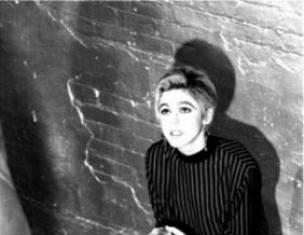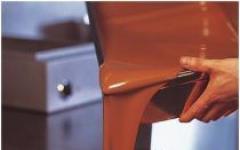Ked "Two balls". New sneakers completely repeat the Soviet-Chinese models - they are produced on the same equipment as in the 1970s and retain the classic design. The Village spoke with the founder of the brand, Evgeny Raikov, about the revival of iconic sneakers, the features of domestic crowdfunding and the production process.
Evgeny Raikov
Founder of Two Balls
After graduating from the Faculty of Management at the National Research University Higher School of Economics, I worked at AFK Sistema and Intellect Telecom. Everything was going well, but I was not very interested, so at some point I left and started doing jeans: I worked for Denis Simachev, helped open the GJO.E store on Nikitsky Boulevard. But the idea to create a brand that would broadcast our national identity did not leave me; I heard from friends about the Soviet “Two balls” sneakers and realized that this is what I need.
In 1957, the VI World Festival of Youth and Students was held in the USSR, to which many foreign juniors came in sneakers. After some time, the Soviet GOST for sneakers was formed, and in 1965 the first model "Two balls" of Soviet-Chinese production appeared. Since the “Two Balls” sneakers were quite durable, comfortable and beautiful, everyone wore them - from Yuri Gagarin to the wolf from “Well, wait a minute!”. The main peak of popularity came in 1965-1975. But by the 1980s, sneakers appeared on the Soviet market, and sneakers faded into the background - they were worn mainly by children and street children.
In 2013, I registered the trademark "Two balls" (in Russia and in the world), there were no legal problems with this. In general, now you can find many abandoned brands (after all, there were no trademarks in the USSR) and, if desired, revive them. A year later, the crowdfunding project "Soviet sneakers" was launched. In total, it was necessary to raise 720 thousand rubles, and I believed that this could be done, since the project was powerfully covered in the media. In America, out of 100 thousand people who come to the site, five thousand place an order, that is, a conversion of 5%. I thought that we would have a conversion of 1% and in the end the amount would be three times more than planned, because the site traffic was just crazy. But the conversion was only 0.02%, and "Soviet sneakers" collected 307 thousand rubles. Despite this, there were many publications, proposals to invest. I realized that the idea is good, it's just that crowdfunding doesn't work in Russia. International experience also spoke of the fact that everything would work out: at that time there were already precedents for the restoration of cult brands, for example, PF Flyers, popular in America in the 1950s, which was first bought out by Converse, and then by New Balance, or the history of the Feiyue brand, or Spring court.
I spent the next year meeting with investors: someone had good conditions, but "gray" money; but for someone it was the other way around - everything was in order with the money, but the conditions were not suitable. After negotiations with about 40 investors, I turned to GJO.E CEO Ilya Nafeev. He liked the idea, and a year later he entered this project.




Production
Now everyone basically works on new technologies, as it is easier and cheaper. The main difference between the new and old technology is how the top of the sneaker is tightened onto the last. It is either sewn like a sock and put on it (this is the hot pot vulcanization technology), or it comes without a bottom part and is attached to the last with glue. Almost all modern sneakers are made in the latter way. We wanted to revive the "Two Balls" in their authentic form, and for this it was necessary to find factories that work with hot pot vulcanization technology (previously it was used everywhere). I visited several Russian shoe factories and realized that it is simply unrealistic to do this here. Unfortunately, we have a completely dead industry, no matter how some enthusiastic companies try to restore it.
I went to China for three weeks and returned after two years. In China, we managed to find factories that worked on the necessary technologies. As a result, we made new sneakers that correspond to Soviet GOSTs. First of all, all molds, patterns, logos and other details were completely restored. We took the old “Two Balls” block as a basis and expanded it a little for convenience - not many people know that the Russians have a wider leg than the Europeans. In addition, the triple layer of cushioning was restored - the sole, insole and insole with arch support, as in sneakers. Previously, the insole was made of heavy foam rubber, we use EVA. The sole also copies the old one - we had a plaster cast, from which we made a 3D scan, then a mold. There was also a line of rubber glue around the perimeter, which does not allow the shoe to crack on the bends. The laces were made of cotton with original weaving, adding engraving to the tips. For the tag, I had to make a special machine, since no one makes such ones at all.
To assemble sneakers, we use 12 factories in 12 different cities. So, laces are produced on one, tips for them - on the other, eyelets - on the third. To ensure that the tips and eyelets are the same color, they are brought to the same factory and galvanized together. The tips are then sent to another province where they are engraved. Then to the next, where they connect with the laces. And that's just one story. The insole has a lot more nuances, but I generally keep quiet about the sole.
Of course, everything could have been done cheaper and worse, but I didn’t want to make just some kind of sneakers with the inscription “Two balls”. In our sneakers, all the details are more complicated than they look, for example, the geometric pattern along the contour flies and gets dirty all the time. In addition, they are assembled by hand, that is, all the lines, all the logos are not made by machines, but by living people. Therefore, sometimes there are some small imperfections - for example, letters can be slightly unevenly painted over. But this is the point of the project - to make the product individual.
Manufactured per day
from 300 to 500 pairs of sneakers
Keds are made on 12 factories in 12 Chinese provinces
The very first model "Two Balls" was released
in 1965






The production price is very high, but we have reduced the final price of the product as much as possible - contrary to all market rules. We plan to sell most of the products through our own online store - this will help recoup the costs. Naturally, Two Balls will also be presented offline, for example, our temporary corner in Tsvetnoy will appear on July 13, and later sneakers can also be found in Sneakerhead stores. Now the price range varies from 3,900 to 4,600 rubles, depending on the model. Some write: “It is very expensive! In "Auchan" sneakers for 500 rubles. Indeed, sneakers can be made from PVC (by the way, the seventh most dangerous poison in the world) and sold for that kind of money. I've been to factories that do this kind of stuff: huge volumes, the cheapest materials - very tough. But we have a poor country, and therefore such a product has a place to be.
Of course, we feel interest from the state, we even communicate with someone, but so far there have been no concrete proposals. It seems to me that the authorities should pay attention to national histories and help them develop. Now many enthusiasts are trying to do something, but in Russia it is difficult: small print runs, lack of fabrics and consumer interest are well-known problems. I decided to make sneakers not in Russia for many reasons. First, we do not have the necessary technology. Secondly, this way the country earns more due to the fact that we refuse various benefits and spend money on transportation. Of course, I am in favor of developing production in our country, but this should be done not by private companies, but by the state. My viable model is to produce in China and keep the creative office in Russia. Russians have very good intellectual capital. After living in China for several years, I fell in love with our compatriots like never before.
We have eight models in total, but on the website in this moment only four are available, one of which is available in two colors. The plans are to release two collections a year at the start, and then increase the turnover in order to gain a foothold not only in our market, but also internationally. By the way, there are already requests from Europe and Japan. Perhaps new models of sneakers will appear, but not in the first years of work for sure. We also want to add basic clothes: T-shirts, backpacks, caps, hoodies.
I am not afraid of competing with such powerful brands as, for example, Converse. Now we are too local to compete with them. If we talk about competition at the level of Russia, then “Two Balls” is closer to our person: they are remembered by everyone who grew up in the USSR. But in general, if you put our sneakers and converses side by side, then there are no questions. In addition, Soviet aesthetics have been in fashion for a long time, they just don’t always know how to cook them correctly. I hope that over time we will learn how to do it perfectly.
Photos: provided by the press service
In the USSR, sneakers became widespread after the Sixth World Festival of Youth and Students, which took place in 1957.
The festival has become in every sense a significant and explosive event for young people - it fell in the middle of the Khrushchev thaw and was remembered for its openness. The foreigners who arrived freely communicated with Muscovites, and this was not pursued. Then the first "Ked's" came to the Soviet Union ...
The domestic industry, without thinking twice, mastered the production of such shoes. Later, GOST 9155 appeared “Rubber and rubber-textile sports shoes. Specifications". By the mid-1960s, the overwhelming majority of Soviet youth wore sneakers. The “Czech shoes” and sandals that bothered everyone were forgotten. The product began to be sold in the USSR in cyclopean volumes.
GOST 9155-88
The Soviet standard (perhaps from a political point of view) was perfectly matched by Chinese and North Korean versions sports shoes.
For several decades, Vietnamese sneakers and half-sneakers were also worn, which practically did not differ from the American “classics” - with a high fabric top, white rubber soles, white rubberized toes and circles on the sides that protect the ankle bones - they were very strong and cost only a few roubles. 
Since 1968, the Finns began to import sneakers - sneakers were imported under the Nokia brand, which is known today in the mobile device market. Moreover, the design of the logo has not changed since the 1960s. 

In the USSR, sneakers were not in short supply. In the 1960s, every student wore them. It was always possible to buy a pair at a nearby sporting goods store, so they were worn without hesitation around the clock in winter and summer, especially since they turned out to be much more comfortable than outdated Czechs. 
Doctors fought against the constant wearing of sneakers in addition to sports and physical education, as it was believed that the feet sweat a lot in them. However, some managed to wear sneakers in winter, putting them on thick woolen socks. 
In 1963, the film “Take us with you, tourists” was released in the USSR, in which the song “Sneakers” sounded on the verses of Leonid Derbenev:
I want to walk all over the earth in sneakers
To see personally what is, what is in the distance,
And you write me letters in small handwriting
Since there is not enough space in the backpack ...
Ten years after the festival of youth, sneakers have already become so rooted in Soviet life that they have become its integral attribute, and every schoolchild in physical education became a line in them. 
In 1967, the American reporter Bill Eppridge came to the country, who filmed the famous Soviet Youth report here, and the pictures show that most of the Soviet youths already wear sneakers.
Photographs by Bill Eppridge from a Soviet Youth report, 1967: 




In 1979, in the novel It's Me, Edichka, Eduard Limonov calls them "snickers" in his own way, and in this form gives them a place in Soviet literature. And Viktor Tsoi, who also fell in love with sneakers, rooted them in the musical culture of the country. 
Sneakers also penetrated Soviet cinema - the android boy Elektronik, adventurers Petrov and Vasechkin, Sharik from Prostokvashino and the broken cartoon Wolf from Nu, you wait! - they all depicted not polished movie images, but ordinary guys in sneakers. 
1. Syroezhkin in sneakers. 2. A ball from Prostokvashino. Instead of things useful in the household, I bought myself sneakers and a photo gun. 3. Wolf from "Well, you wait!". 4. Viktor Tsoi in sneakers. 5. Schoolchildren in physical education. 6. Classic Soviet sports bow. 7. The owners of the "Two Balls" did not part with them even on the beach. 8. Boys in the camp. 9. A boy in Chinese “Two Balls” sneakers flirts with a girl in less prestigious Lithuanian Inkaras Kaunas sneakers. 10. Outdoor sneakers. 11. Guys play streetball. 
Soviet sneakers had soles in light or red shades with a clearly marked seam, turning into a textile upper, usually blue or black. 
Shoelaces were most often white and had metal tips. Most Soviet models had protective round stripes stylized as a ball on the inside in the ankle area. 

Sneakers "Two balls" were considered a special chic. They were made in China and, strange as it sounds today, differed the highest quality. They were more difficult to get, and the colors and designs differed from common models, which made them a cult object. 
sneakers of blue color featured a more durable green sole, while the trim, toe and laces were white. On the inside, in the region of the bone, there was a round emblem with two balls - a football and a basketball. 
The most precious item was the all-white "Two Balls" sneakers. They cost four rubles, and similar Chinese Warrior and Vietnamese Forward - three. 


Keds came to the USSR along with Sixth World Festival of Youth and Students. It took place in 1957, and it was then that Soviet youth in sandals and patent leather boots saw through the iron curtain comfortable shoes with rubber soles. Soon, GOST appeared in the country for “Rubber and rubber-textile sports shoes” under the number 9155-88, and sneakers began to be imported into the USSR from China, North Korea and Finland.
Their sneakers appeared in the USSR in the mid-60s. They were called "Two balls" and hit the shelves in 1965. It was one of the first Soviet-Chinese collaborations in footwear production. And it was a resounding success. In 1967, American journalist Bill Eppridge, who came to the USSR to shoot his famous report Soviet Youth, captured on film Soviet youths, who without exception walked in sneakers. "Two balls" penetrated not only on sports and dance floors, but even on the stage and in the cultural environment. The wolf walked in sneakers from "Wait for it!", Yuri Gagarin, basketball star Sergei Belov, Viktor Tsoi and Electronics with Syroezhkin. Owners "Two balls" did not part with them even on the beach, combining sneakers with swimming trunks.
Soviet sneakers were produced in gigantic batches, while, as the founder of the modern project notes "Two balls"
Evgeny Raikov, "they were made so high quality that we could improve them only in details." But unexpectedly in the late 80s - early 90s they disappeared from the shelves.
press service "Two balls"
To fix this, a team led by Raikov undertook: they found a factory where the equipment was preserved, on which "Two balls" were made more than 40 years ago, and added to this new technologies that provided additional shock absorption of the foot and impeccable design. “Our sneakers are interesting because they were created using reverse engineering,” says Evgeny Raikov. - It turned out that most of the old patterns and molds were lost, and we reproduced many samples according to authentic sneakers that we inherited from our ancestors. The step-by-step restoration allowed us to delve deeply into all the details of production, so, step by step, we restored the classics and improved many indicators.









© press-service "Two balls"
© press-service "Two balls"
© press-service "Two balls"
© press-service "Two balls"
© press-service "Two balls"
Five models of sneakers. Their price ranges from 3.9 to 4.9 thousand rubles. And in the future, the collection will be replenished with more than ten models. “Production is not as fast and cheap as modern mass-market sneakers. But at the end we get those very good old Soviet sneakers, ”Raikov summed up.
Sports shoes are in fashion right now. It is worn by both youth and adults. Recently, eclecticism has been in trend - a combination of styles. Girls wear sports shoes with dresses, men wear classic suits. This type of shoe has become a symbol of democracy, freedom and convenience. Let's remember the history and talk about when the first sneakers appeared and what they were like in the USSR, because most readers remember these comfortable and fashionable shoes well.
Revival: iconic sneakers
In 2016, a young designer and entrepreneur Evgeny Raikov presented his compatriots with the same sneakers! He took the matter seriously. I found the same factory in China that made Soviet sneakers. The Chinese have no old patterns left. I had to create new patterns, according to samples of finished products of the Soviet era. It must be said that the project was quite successful. Party shoes under the brand name "Two balls" disperse like hot cakes.

Ancestors of sports shoes
About a hundred years ago, sneakers were intended exclusively for people who were professionally involved in sports. No one could even think that these sports shoes would become so trendy. Throughout the history of development, sneakers have gradually turned into an epoch-making phenomenon. Now they have become a cult object. Shoes are loved by many people around the world.
The first shoes similar to sneakers appeared in the thirties of the XIX century. Oddly enough, but it was created for walking along the beach. The first sand shoes were called. Where did the modern name come from?
It was first mentioned in 1916. The name came from the Keds shoe brand. If you dig deeper, it is worth remembering 1892. Then there was a merger of nine factories that made rubber shoes. They were united under the same name U.S. rubber company. Goodyear also joined this alliance. It held the rights to the vulcanization technology and also specialized in shoes with rubber soles and canvas uppers.

The first name of this shoe sounded like peds. It arose because they were in most cases worn by the poor. In American slang, such people were called "peds." But it turned out that such a name already exists, and it had to be replaced. Since the brand that produced sneakers was focused on children and teenagers, marketers came up with the idea of combining the words kid and ped. If it weren’t for this, then everyone’s favorite shoes would still have the name “pedy”.
The hype around fashionable shoes began in 1917. Then the American Marcus Convers launched a line of sneakers for professional basketball players. Hard to find today young man who would not know this model. These are the legendary Converse All Star.
Chuck Taylor and the famous Chucks
You may have heard that these sneakers are also called “chucks”. Where did the strange name come from? The fact is that in 1919 an athlete who became a basketball legend put on the Converse. He was the first to be inducted into the Basketball Hall of Fame. Markus Konvers invited him to become the face of the brand. Later, the sneakers he advertised became known as the Chuck Tayor All Star. In youth slang, they acquired the name "Chucks".
After a while, other athletes began to train at Converse All Star. In 1950, a third of all NBA athletes became Converse fans. American sneakers have long broken all records in their segment. Over the entire history, 800 million copies have been sold.
There have been hard times in the history of Converse. In the 1940s, all US forces were thrown into the military industry, there was no time to release fashion shoes. The textile industry worked to provide uniforms for the fighters. Because of this, the production of sneakers almost stopped. The brand returned to its former volumes only in 1966. At the same time, the competitors of Mark Converse began to raise their heads.
Japanese miracle sneakers
In 1951, the Japanese began to make shoes for basketball players. They approach this matter with their characteristic scrupulousness. Kihachiro Onitsuka with Onitsuka Tiger creates a sole that is unparalleled in the world. The brand name will later be called Asics. The design is designed on the principle of octopus suction cups. The technology provides excellent grip of shoes with the surface on which basketball players run. When in the 21st century they undertook to reissue this and subsequent models, the line made a splash!
Youth Festival
Let's move on to the sneakers of the times of the USSR. How did American shoes come to our country, despite the "Iron Curtain"? In the USSR they were seen for the first time in 1957. The fact is that at that time the Sixth World Youth Festival was taking place. Students gathered from all ideologically free continents and the socialist camp. Boys and girls from noble exemplary families were shod in patent leather shoes, but progressive youth in American sneakers.
Exclusively according to GOST
Shoes began to slowly acquire relevance, and sneakers in the USSR began to be made in small volumes. Soon after the youth festival, GOST was approved for these products. Keds in the USSR (pictured below) had the number 9155-88.

There were also foreign analogues of sports shoes in the USSR, only they hit the shelves not from the liberal USA. The quality criteria of the USSR were more suitable for shoes from North Korea and China. Most likely, politics was involved here. In 1968, sneakers from Finland appeared in the country. Interestingly, they were imported under the Nokia brand. Now we know this trademark as a manufacturer mobile phones. The company logo, by the way, has not changed since the 60s.
Keds in the USSR were produced in huge volumes. In the 60s, all schoolchildren wore them, students put them on potatoes. Men's shoes in the USSR they were worn by workers at all construction sites. This trend can be seen by watching Soviet films. Women also wore these shoes with pleasure.
If suddenly the pair broke, then you could buy a replacement in every sporting goods store. There were a lot of these stores in the USSR. The Czechs, which were previously worn for physical education classes, are rather tired of everyone. The boots were much more comfortable.

A dozen years after the legendary festival, these sports shoes entered the life of Soviet citizens very tightly. The sneaker from the times of the USSR has another name. In 1979, in the novel by Eduard Limonov "It's me, Eddie" the name "snickers" is first encountered. The name was also popularized by Viktor Tsoi.

We remember sneakers in Soviet cinema. They were worn by Elektronik, friends Petrov and Vasechkin. Even Sharik from Prostokvashino preferred these sports shoes. But the most colorful cartoon character in sneakers was a wolf from "Well, you wait!".
Sneakers "Red triangle"
Every autumn, a report from the Red Triangle factory is shown on TV. Brand new sneakers of different colors descend from its conveyors. Despite the fact that the shoes were very simple, millions of children and teenagers are in love with them.

In the mid-seventies, sneakers conquer all generations, young and old. They go jogging, go on dates, walk in parks, work in factories. "Red Triangle" produces sneakers for very affordable price. Millions of pairs of these sports shoes are made every year by factory workers. It was hard to buy sneakers in small towns. Basically, they went to Moscow and Leningrad. People stand in line for hours, but they leave the stores with joy on their faces - they are taking home Red Triangle sneakers. In the USSR, an ordinary pair cost 3 rubles. The “Two Balls” sneakers were more expensive. They cost 4 rubles. We will discuss them separately below.
A little higher are the Red Triangle sneakers (USSR) in the photo. Shoes had soles of red or milky color. It was possible to meet completely in the USSR. The seam clearly marked the transition from the sole to the textile upper. Laces were most often white color. Their tips are made of metal. In the ankle area, on the inside, the sneakers had protective round stripes that resembled a ball.
"Two Balls" is a line of sneakers that were made in China. It was an example of China's successful cooperation with the union. Sneakers "Two balls" were an order of magnitude better, but Chinese shoes was much more difficult to obtain.

Such batches were much better than sneakers sewn in the union, because in the USSR they used injection technology, and in China - hot vulcanization. Comes with Chinese-made sneakers orthopedic insole. The fabric from which the upper was made was also much stronger. The colors and design of sports shoes also differed greatly from domestic counterparts. This made the Two Ball sneakers almost a cult item.
The Chinese manufacturer offered several colors of shoes. Blue sneakers had a durable bottle glass sole. The laces and toe were white. From the inner side in the area of the bone is the legendary emblem with a football and a basketball.
The most expensive were white sneakers "Two balls". They were several times more expensive than their colored counterparts. Some fashionistas bought colored shoes and boiled them to a state of whiteness.








